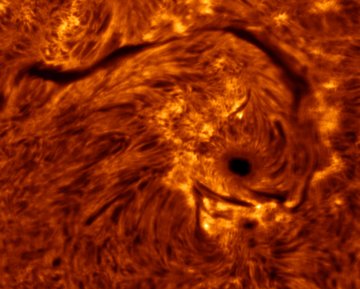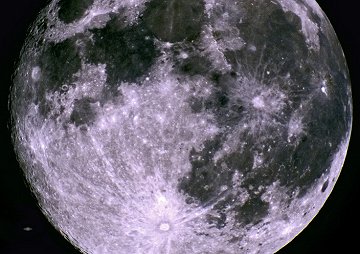 Did you sleep through the auroras of Dec. 14th? Next time get a wake-up call: Spaceweather PHONE.
Did you sleep through the auroras of Dec. 14th? Next time get a wake-up call: Spaceweather PHONE.
181 THINGS TO DO: If you woke up tomorrow morning and found yourself on the Moon, what would you do? NASA has just released a list of 181 good ideas: full story.
LIQUID FILAMENT: Warning. Staring too long at this photo may cause sensations of dizziness:

Click to see the filament in motion (8 MB).
Gary Palmer of Los Angeles photographed sunspot 940 yesterday, capturing a dark, magnetic filament swirling up and out of the spot's core. He calls it the "Liquid Filament" because of its fluid motions: 8 MB movie. Sunspot 940 and its vertiginous filament are near the center of the sun this weekend--easy targets for backyard solar telescopes. Take a look!
more images: from Patricia Cannaerts of Belgium; from Franck Charlier of Marines, Val d'Oise, France; from Greg Piepol of Rockville, Md; from John Stetson of Falmouth, Maine; from Denis Joye of Boulogne, France.
ODD COUPLE: Last night, the Moon glided beautifully close to the ringed planet Saturn. P-M Hedén took this picture from Vallentuna, Sweden:

Photo details: Orion 80ED 600mm, Canon Digital Rebel XT
"I couldn't see Saturn with the naked eyes because of the Moon's glare" says Hedén, "but when I aimed my Orion 80ED at the moon, the sight was really great--a tiny Saturn with rings right beside our great moon!"
more images: from Mohammad Shirani of Dubai ,UAE; from Günther Strauch of Borken, NRW, Germany; from Riccardo Di Nasso of Pisa, Tuscany, Italy; from Peter van Leuteren of Cosmos Observatory, Lattrop (Twente), the Netherlands; from Paul Evans of Larne, Northern Ireland; from Sorin Hotea of Sighet, Romania;

